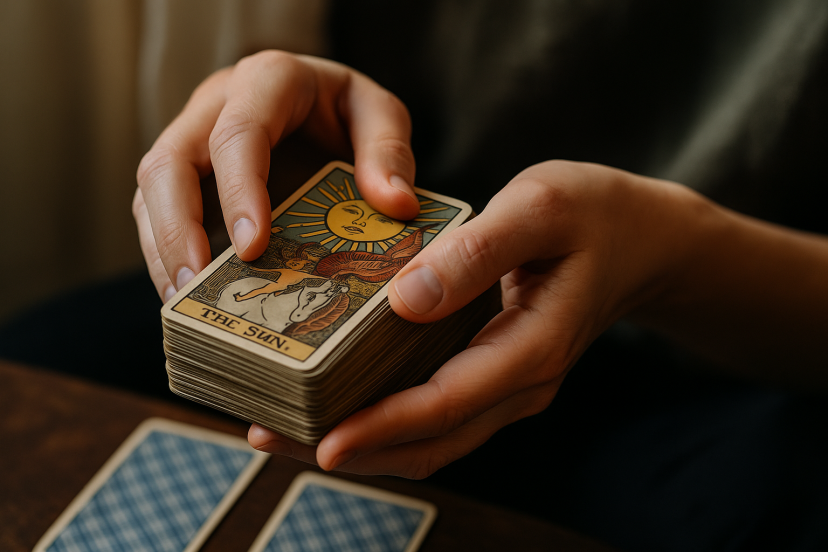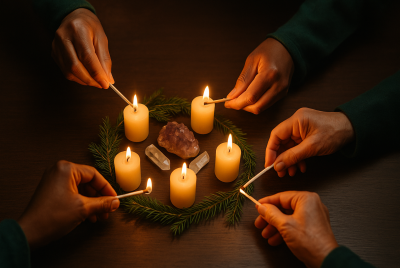Best Tarot Cards for Spiritual Growth and Inner Wisdom
We may earn a commission for purchases made using our links. Please see our disclosure to learn more.
Have you ever held a tarot deck and felt that quiet nudge—maybe this could help me hear myself more clearly? That’s the real magic of tarot. It isn’t about dramatic fortune-telling; it’s about tuning into your inner guidance, moving through blocks, and choosing your next step with intention. If you’ve been searching for the best tarot cards for spiritual growth and inner wisdom, this guide is your safe, cozy corner. We’ll explore how tarot supports personal evolution, walk through practical rituals, and compare five beloved decks you can confidently buy today.
Why Tarot Supports Spiritual Growth
Tarot is a mirror, not a megaphone. The 78 archetypes reflect patterns you’re living right now—fears, hopes, habits, and hidden strengths—so you can see your story with kinder eyes. Used consistently, tarot helps you:
- Spot unhelpful loops (hello, overthinking).
- Reframe challenges as invitations to grow.
- Strengthen intuition by practicing inner listening.
- Create meaning from crossroads, endings, and new beginnings.
Think of tarot like journaling with pictures—symbolic images that spark insight faster than a blank page ever could.
Inner Wisdom vs. External Noise
We’re drenched in advice: feeds, gurus, listicles. Tarot invites you to step out of the noise and ask, What do I already know?
A quick practice: shuffle and pull one card while asking, “What truth am I avoiding?” Sit with the imagery for two minutes. Notice what rises. Your body recognizes honesty before your brain agrees.
How to Choose the Right Deck for You
Ask yourself:
- Do I love the artwork? You’ll spend time with these images—connection matters.
- Traditional or modern symbolism? Classic Rider-Waite clones teach fundamentals; modern decks can feel more relatable.
- What energy do I need now? Healing? Empowerment? Shadow integration?
- Is it practical? Card size, cardstock, readability, and guidebook quality influence daily use.
Pro tip: your best deck feels like a friend—supportive, honest, and easy to be around.
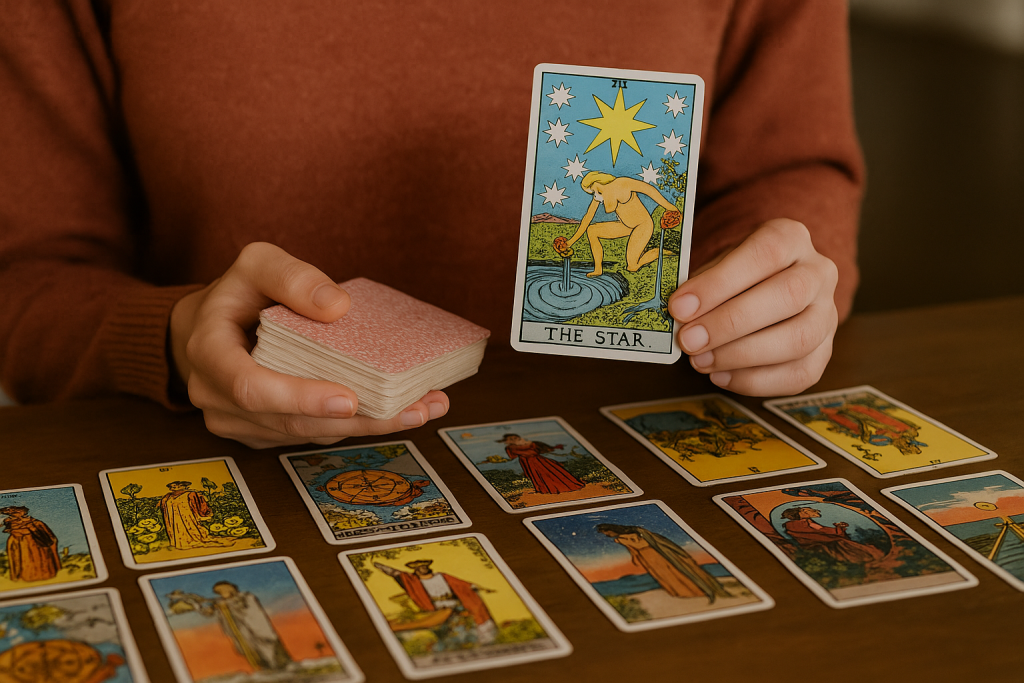
Tarot vs. Oracle: Which Serves Growth Best?
- Tarot: a structured system (78 cards, consistent suits/majors). Great for learning archetypes and mapping progress.
- Oracle: flexible themes and counts. Wonderful for quick affirmation pulls or mood-based guidance.
Use both if you like, but for deep, trackable spiritual work, tarot’s structure shines.
Reading Styles that Accelerate Growth
- Daily one-card: “What energy should I embody today?”
- Three-card clarity: Past–Present–Lesson or Mind–Body–Spirit.
- Weekly growth spread: Shadow to face, Support to lean on, Step to take.
- Seasonal check-ins: solstices/equinoxes for big-picture direction.
Rituals to Ground Your Practice
- Start with breath (four slow inhales/exhales).
- Set an intention (“Show me what helps me grow with compassion.”)
- Close with gratitude (thank your deck, your intuition, your courage).
- Journal a sentence you can act on today.
Common Beginner Mistakes (and Easy Fixes)
- Treating cards as verdicts → Reframe them as conversations.
- Over-pulling for the same question → Pick one insight and practice it for 24 hours.
- Ignoring reversals or shadow cards → That’s where many breakthroughs live.
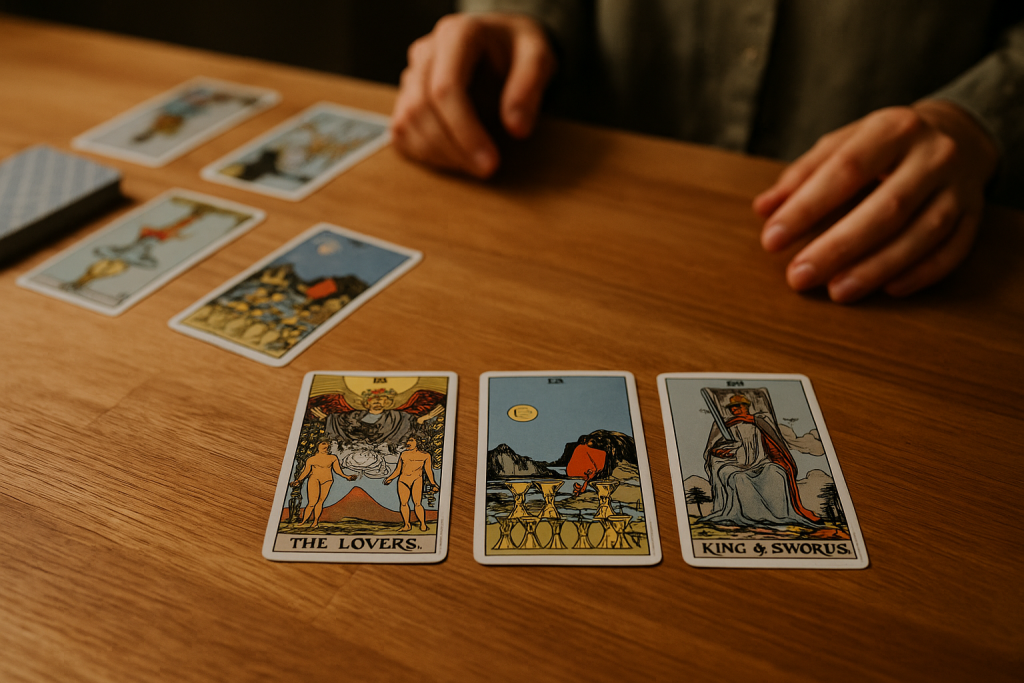
Top 5 Best Tarot Cards for Spiritual Growth and Inner Wisdom (Amazon Picks)
I chose decks that balance clarity, emotional depth, and long-term growth—along with easy availability and strong community support.
1) Rider–Waite–Smith (U.S. Games Systems)
The classic foundation for learning archetypes. Its straightforward imagery makes “aha” moments frequent, especially for beginners.
- Features: 78 traditional cards, clear symbolism.
- Pros: Most tutorials use it; easy to study; versatile.
- Cons: Artwork can feel dated to some.
- Best for: Starters who want a solid base and measurable progress.
Available widely via U.S. Games Systems’ editions.
2) The Wild Unknown Tarot (Kim Krans)
Nature-driven, hand-drawn art invites quiet reflection and potent shadow work.
- Features: Animal/elemental themes; keepsake box set options.
- Pros: Meditative, intuitive, emotionally resonant.
- Cons: Minimalist imagery can challenge total beginners.
- Best for: Readers who process feelings through symbolism and nature.
The official keepsake set remains a favorite.
3) Modern Witch Tarot (Lisa Sterle, Liminal 11)
A contemporary, inclusive spin on Rider-Waite that radiates empowerment.
- Features: Bold color, diverse representation.
- Pros: Relatable characters; great for self-esteem and confidence spreads.
- Cons: Stiffer cardstock on some print runs.
- Best for: Empowerment, identity work, modern aesthetics.
See Liminal 11’s overview for creator intent and symbolism.
4) Light Seer’s Tarot (Chris-Anne, Hay House)
A soulful deck balancing light and shadow, excellent for healing and mindset growth.
- Features: Vibrant imagery, intuitive guidebook.
- Pros: Uplifting tone; versatile across spreads.
- Cons: Some non-traditional depictions.
- Best for: Emotional healing, reframing narratives, creative careers.
Available in standard and pocket editions.
5) Thoth Tarot (Aleister Crowley & Lady Frieda Harris, U.S. Games)
Steeped in esoterica; transformative if you enjoy depth and study.
- Features: Rich occult layers; multiple sizes/editions.
- Pros: Intellectually stimulating; powerful for big-picture growth.
- Cons: Steeper learning curve.
- Best for: Advanced seekers and symbolism lovers.
Check U.S. Games editions (small/premier/large).
Comparison Table: 5 Growth-Focused Decks
| Deck | Style/Theme | Best For | Standout Strength | Watch-out |
| Rider–Waite–Smith | Classic, structured | Beginners | Teaches archetypes clearly | Old-style art |
| The Wild Unknown | Nature, minimalist | Shadow work, intuition | Meditative focus | Abstract images |
| Modern Witch | Inclusive, modern | Empowerment | Relatability & diversity | Stiff cardstock |
| Light Seer’s | Modern, soulful | Healing & reframes | Uplifting energy | Non-traditional depictions |
| Thoth | Esoteric, layered | Advanced study | Depth of symbolism | Learning curve |
A 7-Day Tarot Plan for Breakthroughs
- Day 1 — Identity: “What part of me wants to be seen?” (Journal three lines.)
- Day 2 — Shadow: “What fear is driving my choices?”
- Day 3 — Support: “What resource am I forgetting?”
- Day 4 — Body Wisdom: “How can I ground this insight today?”
- Day 5 — Relationship: “What truth needs a gentle conversation?”
- Day 6 — Purpose: “Where does my energy want to flow next?”
- Day 7 — Integration: “What practice will I commit to this week?”
Shadow Work, But With Self-Compassion
Pull a “shadow” card (e.g., The Moon, Devil, 5 of Cups) and ask:
- What protective job is this pattern doing for me?
- What would a kinder strategy look like?
- What small boundary or habit change supports me today?
Shadow work isn’t self-punishment—it’s self-parenting.
Cultural Perspectives on Archetypes and Symbols
Archetypes show up across cultures—the wise elder, the trickster, the healer. That’s part of why tarot resonates globally: the images hint at universal life passages. Scholarship continues exploring how symbolic images invite reflection and meaning-making across contexts—precisely the muscles you’re training with tarot.
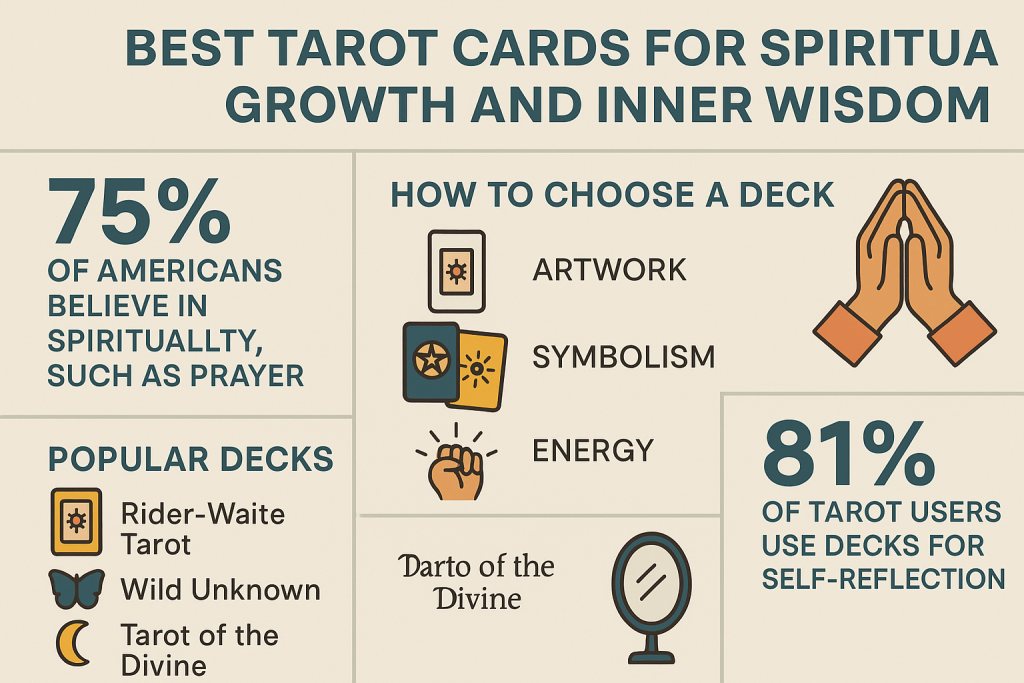
🧪 Research-Backed Insights (Plain-English)
1) Mental imagery can boost mood and interpretation.
A review published in Frontiers in Psychiatry shows that practicing positive mental imagery helps lift mood and shape how we interpret uncertain situations. In simple terms: working with supportive images (like tarot’s archetypes) can help your brain lean toward more hopeful and resourceful patterns. That’s exactly why uplifting decks such as the Light Seer’s Tarot feel so transformative during growth seasons.
2) Meaning-making supports resilience and well-being.
Research in Frontiers in Psychology highlights that constructing personal meaning—turning experiences into a coherent story—helps people adapt during stressful transitions. Tarot naturally encourages this reflective storytelling: you interpret symbols, create language, and apply insights to your life. That’s why consistent practice with a deck like the Rider–Waite–Smith can feel grounding when everything else feels uncertain.
3) Symbolic imagery enhances emotional processing.
According to a study summarized in the Journal of Humanistic Psychology, engaging with archetypes and symbolic imagery helps people process emotions and gain clarity. This backs up what many readers experience: tarot cards often bring unconscious feelings to the surface in a safe, reflective way, making inner healing possible.
FAQs
What is the best tarot deck for beginners focused on growth?
Rider–Waite–Smith is the most supported for learning; resources and tutorials map directly to its imagery, making progress fast and trackable.
Can tarot help with healing past wounds?
Yes—tarot fosters reflection and meaning-making, which research connects to better adaptation and resilience. It’s a complement to (not a replacement for) therapy.
How often should I read for spiritual growth?
Consistency beats intensity. Try a daily one-card or a weekly three-card check-in you can actually stick with.
Do I have to be “psychic” to utilize tarot?
Nope. Tarot is a conversation with your intuition. Curiosity + practice = skill.
What’s the difference between light, shadow, and “balanced” decks?
“Light” decks (e.g., Light Seer’s) lean uplifting; “shadow”-friendly decks (e.g., Wild Unknown) invite depth; balanced classics (e.g., RWS) cover both clearly. Choose what supports your season.
Helpful Resource: Pair Tarot with Beach Meditation
Want a soothing companion practice? Try this gentle guide to beach meditation—perfect for grounding after a deep reading and for softening anxious edges before you pull cards. Explore the beach meditation guide here.
Conclusion: Choose the Deck That Meets You Where You Are
Spiritual growth isn’t a race; it’s an intimacy with your own becoming. The “best” deck is the one you’ll reach for—on bright days and messy ones. If you want a sure-footed start, go Rider–Waite–Smith. If you crave modern empowerment, try Modern Witch. For healing reframes, Light Seer’s. For contemplative depth, The Wild Unknown. For intellectual, esoteric exploration, Thoth.
Whichever you pick, set a kind intention, shuffle with presence, and let your inner wisdom speak. You’re already on the path.

